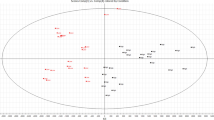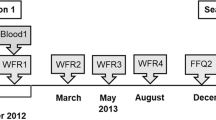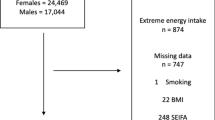Abstract
Background/Objectives:
To validate 24 h dietary recall of fruit intake by measuring the total 24 h excretion of 10 different flavonoids in 24 h urine during an intervention with free fruit at workplaces.
Subjects/Methods:
Employees at workplaces offering a free-fruit program, consisting of daily free and easy access to fresh fruit, and controls employees at workplaces with no free-fruit program were enrolled in this validation study (n=103). Dietary intake was assessed by using a 24 h dietary recall questionnaire at baseline and approximately 5 months later. Ten flavonoids, quercetin, isorhamnetin, tamarixetin, kaempferol, hesperetin, naringenin, eriodictyol, daidzein, genistein, and phloretin, were measured using HPLC–electrospray ionization–MS.
Results:
The 24 h urinary excretion of total flavonoids and the estimated intake of fruits were significantly correlated (rs=0.31, P<0.01). The dietary intake of citrus fruits and citrus juices was significantly correlated with total excretion of citrus specific flavonoids (rs=0.28, P<0.01), and orange was positively correlated with naringenin (rs=0.24, P<0.01) and hesperetin (rs=0.24, P<0.01). Phloretin in urine was correlated with apple intake (rs=0.22, P<0.01) and also with overall estimated intake of fruit (rs=0.22, P<0.01).
Conclusions:
This study shows that a 24 h dietary recall can be used as a valid estimate of the intake of fruits in agreement with an objective biomarker of fruit intake in free fruit at workplace interventions.
This is a preview of subscription content, access via your institution
Access options
Subscribe to this journal
Receive 12 print issues and online access
$259.00 per year
only $21.58 per issue
Buy this article
- Purchase on Springer Link
- Instant access to full article PDF
Prices may be subject to local taxes which are calculated during checkout

Similar content being viewed by others
References
Ashfield-Watt PA, Welch AA, Day NE, Bingham SA (2004). Is ‘five-a-day’ an effective way of increasing fruit and vegetable intakes? Public Health Nutr 7, 257–261.
Astrup A, Andersen NL, Stender S, Trolle E (2005). Kostrådene 2005. Copenhagen, Ernæringsrådet og Danmarks Fødevareforskning. 9-8-2007.
Brantsæter AL, Haugen M, Rasmussen SE, Alexander J, Samuelsen AO, Meltzer HM (2007). Urine flavonoids and plasma carotenoids in the validation of fruit, vegetable and tea intake during pregnancy in the Norwegian Mother and Child Cohort Study (MoBa). Public Health Nutr 10, 838–847.
Brevik A, Rasmussen SE, Drevon CA, Andersen LF (2004). Urinary excretion of flavonoids reflect even small changes in the dietary intake of fruits and vegetables. CEBP 13, 843–848.
Dauchet L, Amouyel P, Hercberg S, Dallongeville J (2006). Fruit and vegetable consumption and risk of coronary heart disease: a meta-analysis of cohort studies. J Nutr 136, 2588–2593.
Duijnhoven FJB, Mesquita HBB De, Ferrari P, Jenab M, Boshuizen HC, Ros MM et al. (2009). Fruit, vegetables, and colorectal cancer risk: the European prospective investigation into cancer and nutrition. Am J Clin Nutr 89, 1441–1452.
Eertmans A, Baeyens F, Van den Bergh O (2001). Food likes and their relative importance in human eating behaviour: review and preliminary suggestions for health promotion. Health Educ Res 16, 443–456.
Fagt S, Biltoft-Jensen A, Matthiessen J, Groth MV, Christensen T, Trolle E (2008). Dietary habits of Denmark 1995–2006 Status and development with focus on fruits, vegetables and added sugar. Report, ISBN: 978-87-92158-19-2, Department of Nutrition, National Food Institute, Technical University of Denmark.
Gibson RS (1990). Principles of Nutritional Assessment. Oxford University Press: Oxford, UK.
Guenther PM, Dodd KW, Reedy J, Krebs-Smith SM (2006). Most Americans eat much less than recommended amounts of fruits and vegetables. J Am Diet Assoc 106, 1371–1379.
He FJ, Nowson CA, Lucas M, MacGregor GA (2007). Increased consumption of fruit and vegetables is related to a reduced risk of coronary heart disease: meta-analysis of cohort studies. J Hum Hypertens 21, 717–728.
Ito H, Gonthier MP, Manach C, Morand C, Mennen L, Rémésy C et al. (2005). Polyphenol levels in human urine after intake of six different polyphenol-rich beverages. Br J Nutr 94, 500–509.
Kipnis V, Midthune D, Freedman LS, Bingham S, Schatzkin A, Subar A et al. (2001). Empirical evidence of correlated biases in dietary assessment instruments and its implications. Am J Epidemiol 153, 394–403.
Krogholm KS, Bredsdorff L, Knuthsen P, Haraldsdóttir J, Rasmussen SE (2010). Relative bioavailability of the flavonoids quercetin, hesperetin and naringenin given simultaneously through diet. EJCN 64, 432–435.
Krogholm KS, Haraldsdottir J, Knuthsen P, Rasmussen SE (2004). Urinary total flavonoid excretion but not 4-pyridoxic acid or potassium can be used as a biomarker for the intake of fruits and vegetables. J Nutr 134, 445–451.
Kimmons J, Gillespie C, Seymour J, Serdula M, Blanck HM (2009). Fruit and vegetable intake among adolescents and adults in the United States: percentage meeting individualized recommendations. J Med 11, 26.
Lassen A, Thorsen AV, Trolle E, Elsig M, Ovesen L (2004). Successful strategies to increase the consumption of fruits and vegetables: results from the Danish ‘6 a day’ Work-site Canteen Model Study. Publich Health Nutr 7, 263–270.
Lyhne N, Christensen T, Groth MV, Fagt S, Biltoft-Jensen A, Hartkopp HB et al. (2005). Dietary Habits in Denmark 2000–2002 Main Results. Danish Institute for Food and Veterinary Research: Soeborg.
Manach C, Williamson G, Morand C, Scalbert A, Remesy C (2005). Bioavailability and bioefficacy of polyphenols in humans. I. Review of 97 bioavailability studies. Am J Clin Nutr 81, 230S–242S.
Mennen LI, Sapinho D, Ito H, Bertrais S, Galan P, Hercberg S et al. (2006). Urinary flavonoids and phenolic acids as biomarkers of intake for polyphenol-rich foods. Br J Nutr 96, 191–198.
Mikkelsen TB, Olsen SF, Rasmussen SE, Osler M (2007). Relative validity of fruit and vegetable intake estimated by the food frequency questionnaire used in the Danish National Birth Cohort. Scand J Public Health 35, 172–179.
Nielsen SE, Freese R, Cornett C, Dragsted LO (2000). Identification and quantification of flavonoids in human urine samples by column-switching liquid chromatography coupled to atmospheric pressure chemical ionization mass spectrometry. Anal Chem 72, 1503–1509.
Nielsen SE, Freese R, Kleemola P, Mutanen M (2002). Flavonoids in human urine as biomarkers for intake of fruits and vegetables. CEBP 11, 459–466.
Ovesen L, Andersen NL, Dragsted LO, Hodtfredsen J, Haraldsdóttir J, Stender K et al. (2007). Frugt, grønt og helbred—Opdatering af vidensgrundlaget (2002). Report, ISBN: 87-91189-60-8, Ministeriet for fødevare, landbrug og fiskeri, fødevaredirektoratet, copenhagen, Denmark.
Riboli E, Norat T (2003). Epidemiologic evidence of the protective effect of fruit and vegetables on cancer risk. Am J Clin Nutr 78 (Suppl), 559S–569S.
Stockley L (2001). Toward public health nutrition strategies in the European Union to implement food based dietary guidelines and to enhance healthier lifestyles. Public Health Nutr 4 (2A), 307–324.
Spencer JPE, El Mohsen MMA, Minihane AM, Mathers JC (2008). Biomarkers of the intake of dietary polyphenols: strengths, limitations and applications in nutrition research. Br J Nutr 99, 12–22.
Acknowledgements
This study is part of the ISAFRUIT project, funded by the European commission under the Thematic Priority 5-Food Quality and Safety of the 6th framework Program of RTD (Contract no. FP6-FOOD–CT-2006-016279). The views and opinions expressed in this publication are purely those of the writers and may not in any circumstances be regarded as stating an official position of the European Commission. We are grateful to the employees who participated in this study for the dedication to this study. Furthermore, we thank Anni Schou for the skilful technical assistance.
Author information
Authors and Affiliations
Corresponding author
Ethics declarations
Competing interests
The authors declare no conflict of interest.
Additional information
Contributors: KSK contributed to the study design, carried out the study, was responsible for statistical calculations, interpreted the data, and wrote the manuscript; LB was responsible for determination of flavonoids in urine by LC–MS, contributed to manuscript editing, and carried out the study; SA carried out the study and contributed to manuscript editing; TC calculated the dietary intake and contributed to manuscript editing; SER contributed to study design and manuscript editing; LOD was responsible for study design and contributed to manuscript editing.
Rights and permissions
About this article
Cite this article
Krogholm, K., Bredsdorff, L., Alinia, S. et al. Free fruit at workplace intervention increases total fruit intake: a validation study using 24 h dietary recall and urinary flavonoid excretion. Eur J Clin Nutr 64, 1222–1228 (2010). https://doi.org/10.1038/ejcn.2010.130
Received:
Revised:
Accepted:
Published:
Issue Date:
DOI: https://doi.org/10.1038/ejcn.2010.130
Keywords
This article is cited by
-
Biomarkers of moderate alcohol intake and alcoholic beverages: a systematic literature review
Genes & Nutrition (2023)
-
Food intake biomarkers for apple, pear, and stone fruit
Genes & Nutrition (2018)
-
A scheme for a flexible classification of dietary and health biomarkers
Genes & Nutrition (2017)
-
Relative validation of 24-h urinary hippuric acid excretion as a biomarker for dietary flavonoid intake from fruit and vegetables in healthy adolescents
European Journal of Nutrition (2017)
-
Availability and Consumption of Fruits and Vegetables Among Non-Hispanic Whites, Blacks, Hispanics, and Asians in the USA: Findings from the 2011–2012 California Health Interview Adult Survey
Journal of Racial and Ethnic Health Disparities (2017)



